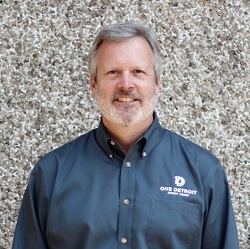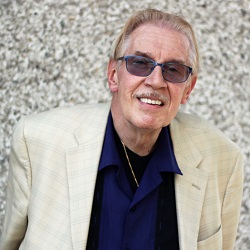More than 1.8 million people lived in Detroit in 1950, according to census data. Today, the city’s population is less than 675,000. Despite the decline, one local financial institution whose founding dates back to the city’s once-booming economy remains steadfast in its service to residents.
Through the years, membership, branches, products, and services at One Detroit Credit Union ($50M, Detroit, MI) have shifted to support a changing community. Fiveyears ago, even the makeup of the board changed. Today, five of the seven board members are people of color, four are younger than 40, and members’ backgrounds include community development, legal, community activism and social work.
But even amid such change, the credit union remains grounded in its mission.

Hank Hubbard, President/CEO, One Detroit Credit Union
‘We basically went back to our roots, serving people who are left out of the financial mainstream,’ says Hank Hubbard, president and CEO of One Detroit since 1991.’We have continued on that path for the past 15 years, and we’replanning to keep doing it. It’s a struggle at times, but we’re making it work.’
Changing Times
The histories of Detroit and One Detroit Credit Union are closely interwoven.
Once home to thousands of blue-collar workers comfortable with the idea of banding together for mutual benefit, Detroit was an ideal environment for credit unions in the early 20th century. In the 1950s, the city boasted nearly 2 million residents anda flourishing automotive industry. However, the city began to change as competition from foreign auto makers increased and manufacturing jobs began to decrease. Race riots in the 1960s accelerated white flight to the suburbs, and eventually, the city’spopulation fell to less than 700,000. Downtown neighborhoods slipped into a freefall of unemployment, urban blight, and high crime.
Founded in 1935 as the Detroit Newspaper Industrial Credit Union, One Detroit expanded its membership in the 1970s to include television and radio stations and changed its name to Communicating Arts Credit Union. During the city’s newspaper unionstrike in 1995, the papers brought in non-union workers from the city’s burgeoning unemployment lines, and the credit union drew in a new kind of member with different kinds of needs.
‘Most of these new members were getting their first good-paying jobs and coming in with credit problems and lower assets,’ Hubbard says.’We were their first exposure to mainstream financial institutions. At the time, we were a sortof boys-with-their-toys credit union. We had union guys with good-paying jobs and stable income buying boats and RVs. But many of them were out, so we had to adapt.’

Staff members of One Detroit celebrate the credit union’s name change and rebranding in 2015.
Changing Products
One Detroit started evolving its product and service offerings to support a low-income market. It is a certified community development financial institution and to date has received $6.8 million in CDFI grants, most of which has gone toward building capacityfor new programs. Here are a few.
Payday Lending Alternative
One Detroit’s service area includes patches of banking deserts where predatory lenders thrive. The credit union has provided lower-interest alternative loans for the past decade, and up to 70% of its membership has saved $1 million each year ininterest via $10 million in payday advances annually.
Auto Loan Refinancing
One Detroit takes on predatory auto loans whose interest rates can reach up to 25%.’Refi My Ride’ loans offer a lower interest rate, repayment terms up to 72 months, and a loan-to-value that exceeds 100%. The credit union launchedRefi My Ride in 2015 with CDFI funding but now offers the option as part of its ongoing loan program. The credit union has helped borrowers save $5 million in interest in the past five years some borrowers have saved hundreds of dollarsa month.
‘In some cases, we’ve saved them $300 a month,’ Hubbard says.’You can buy a lot with $300.’
Home Rehabilitation
Plunging home values in low-income communities have prevented many homeowners from accessing credit to repair their homes. One Detroit has partnered with the city, community development corporations, contractors, and other non-credit union lenders tolaunch a 0% interest program that offers up to 150% loan-to-value for borrowers with credit scores in the mid-500s.
‘We are part of a group of many different stakeholders that made this a reality,’ Hubbard says.
To date, the loans have helped rehab nearly 200 buildings.
Savings Lottery
Despite a variety of programs aimed at helping riskier members, for members, cash in hand can be as important as credit to their name. The average share balance for members of One Detroit is less than $100. So, in addition to offering competitive lendingprograms for low-income members, the credit union also provides products to help them build savings. For example, it participates in Save to Win, an award-winning prize-linked savings programthat has given winners in Michigan up to $5,000.
Each of these programs has receivedCUNA’s Louise Herring Award, which recognizes credit unionsthat apply their philosophy to improve financial matters and increase financial education for members.
Changing Board
In 2015, board members from the credit union’s newspaper era began retiring. The board of directors had led the successful transition to a community-based institution,and the credit union now needed a board that reflected its new membership base.
‘We were looking for people who more directly reflected our community because the community had changed,’ Hubbard says.’We were looking for younger African Americans. Now, five out of seven board members are people of color, three outof seven are women, and four out of seven are younger than 40. We’ve got community development people, a lawyer, a CPA and another financial person, a community activist, and a retired social worker. We’ve got a pretty wide breadth ofexperiences on the board now.’
Board chair Orlando Bailey started his career in community development eight years ago at the Eastside Community Network. A Detroit native, Bailey co-hosts and produces the podcast, Authentically Detroit’ and contributes a regular segment,’The Millennial Moment,’ to 105.9 KISS/FM. He also is the engagement directorat BridgeDetroit, a non-profit news and engagement organization.

Orlando Bailey, Board Chair, One Detroit Credit Union
‘When I came on the One Detroit Credit Union board of directors, my skillset fit comfortably with the group,’ Bailey says.’I was looking to deepen and develop meaningful relationships in the community.’
Patrick Heron, a board member at One Detroit for more than 20 years, is a licensed social worker and former college educator who retired as president and CEO atCommunity Social Services of Wayne County.
‘My transition to the board was smooth,’ Heron says.’I was a credit union member for 10 years prior to joining the board, and I have a family history of credit union membership dating back to the 1930s at various credit unions.’

Patrick Heron, Board Member, One Detroit Credit Union
Hubbard says it’s important to be intentional about choosing new board members. The credit union’s associate board which participates in board decisions but does not vote ensures qualified members attain valuable knowledgeabout what it means to serve a cooperative and are ready to step up when needed.
‘None of our board members are in it for resume building,’ Hubbard adds.’They’re in it for the mission; it’s really amazing.’
According to Bailey, One Detroit’s board members are committed to providing reputable financial services to citizens that have been completely locked out of traditional banks and even changed the credit union’s mission statement to reflectthat streamlined, laser focus.
‘A couple of years ago, we changed our mission to impact and change lives,” Bailey says.’Its simple, and it serves as the bedrock of all of the services we provide. Folks in the community have contacted me sayingthey never thought they would be able to get an account anywhere, but they got one at One Detroit.’
Change was welcomed among the organization’s members. Leaders had to embrace the change, too. Hubbard, for example, had worked with the same board members during his first 15 years at the credit union, and remaking the board required him to stepout of his comfort zone.
‘There was a different perspective and a big learning curve for me to understand what their expectations were and how to best report the information they wanted to see,’ the CEO says.’It wasn’t bad, it was just different.’
For the board members, Bailey and Heron say expanding services to other areas of Detroit and developing relationships within the community has been a rewarding experience. Of course, those relationships have room to grow.
‘I would like to see One Detroit explore and engage in more business with local business entities, including the emerging marijuana enterprises,’ Heron says.
The New Normal
One Detroit relies on a variety of transaction fees for its main revenue source. After state-imposed, stay-at-home orders went into place in March, the credit union’s income fell dramatically. The credit union had to temporarily close two of itsthree branches and lay off some of its 35 employees, most of whom it brought back in the fall.
CU QUICK FACTS
One Detroit Credit Union
Data as of 09.30.20
HQ: Detroit, MI
ASSETS: $50.0M
MEMBERS: 11,501
BRANCHES: 3
12-MO SHARE GROWTH: 31.3%
12-MO LOAN GROWTH: -5.8%
ROA: -0.58%
‘COVID hit us pretty hard,’ Hubbard says.’We’ve always had fairly high comparative expenses and our income dried up. But we’re back on an upswing and feeling pretty confident.’
The credit union explored merging in the early 2000s, back when it had just $20 million in assets. Smaller credit unions, as well as a one larger one, pledged to continue serving Detroit in the event of a merger, but the board ultimately rejected theoption, reasoning that one bad year in Detroit could change the credit union’s commitment to the community.
‘We shifted our focus to the community,’ Hubbard says.’That opened the door for us. We were able to take advantage of things like CDFI grants, which has kept us from thinking about mergers.’
Seven years ago, the city of Detroit made headlines when it filed the largest municipal bankruptcy in terms of debt, but since then, the city has been showing signs of recovery. State and private investments helped lift the city out of bankruptcy within 13 months. More recently, the private sector helped establish landmark mixed-use developments in the city’s downtown, midtown,and warehouse districts.
Millennials who grew up in the suburbs are now moving back to participate in the revitalized urban experience. However, there’s a lot that still needs to be done to revitalize the city’s abandoned neighborhoods and businesses. According to Heron, the credit union is committed to serving the city’s urban community, even calling it a key to the credit union’s long-term success.
‘One Detroit has a great staff, excellent leadership, and a reputation for diversity throughout the organization,’ Heron says.’We are engaged with our community, and I think our working relationship with the community will expand.’